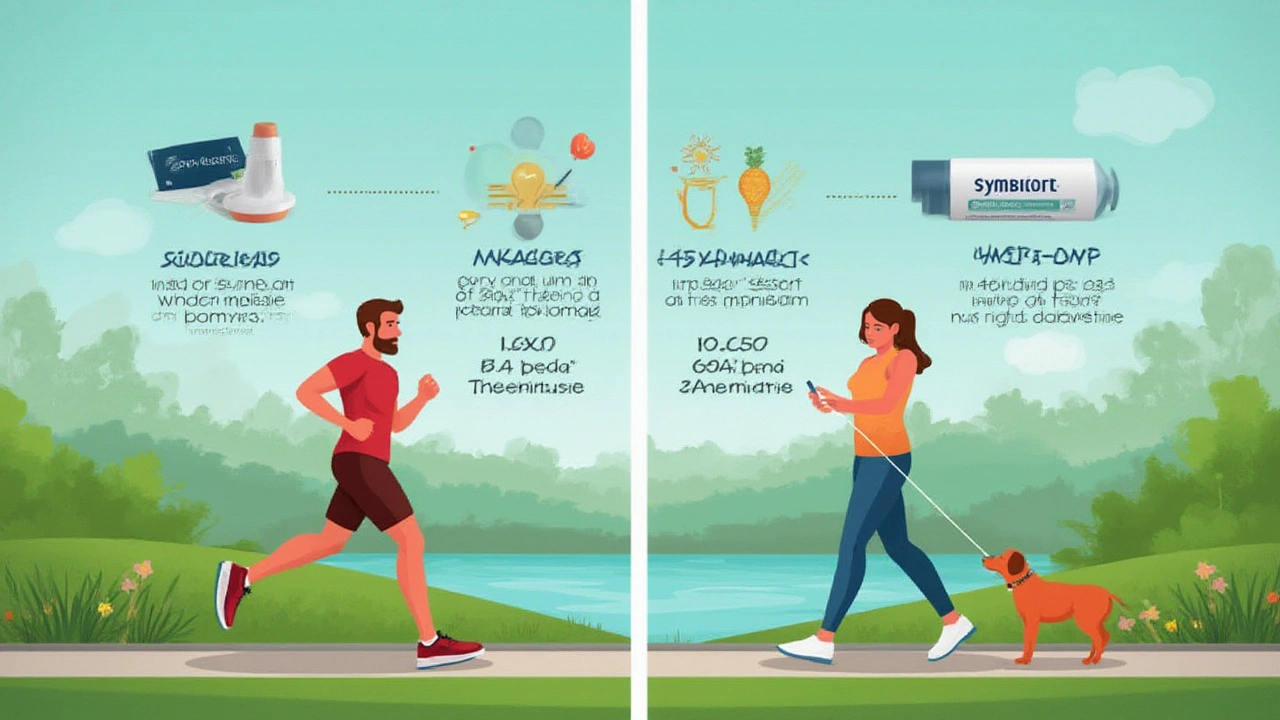The rivalry between Dulera and Symbicort isn’t just a pharmacy shelf showdown—it affects how millions breathe, live, and manage their days. If you’re trying to get your asthma under control or find steadier ground with COPD, these two names have probably come up at your doctor’s office. What’s wild is how many folks still don’t know how much these combos actually differ in real life. Today, we’re jumping into the head-to-head of two heavy hitters: Dulera vs Symbicort. It’s not just about what’s written on paper—efficacy, convenience, price tags, side effects, and even how users feel day-to-day all go into picking a winner. There’s no one-size-fits-all, and the decision can shape quality of life. Let’s see if the gaps between these two actually matter or if they’re just brand battles over the same result.
Breaking Down the Science: How Dulera and Symbicort Work
Both Dulera and Symbicort are designed as combination inhalers, packing two medicines per puff: an inhaled corticosteroid (ICS) and a long-acting beta-agonist (LABA). For Dulera, it’s mometasone (the corticosteroid that calms inflammation) and formoterol (the quick-onset ‘beta-agonist’ that relaxes tight airways for hours). Symbicort pairs budesonide (a well-known steroid) with the same LABA, formoterol.
Now, here’s an underrated fact: formoterol acts super fast but also sticks around for hours—making both inhalers uniquely suited for "maintenance" therapy in moderate-to-severe asthma treatment and COPD. The mechanism is straightforward—ICS tamps down chronic swelling inside the airways, and LABA opens you up so you can actually get that air in and out. Used as directed, both are proven to cut down hospital visits and prevent flare-ups. What’s less obvious is which steroid component works better for different people and why.
Let’s get geeky for a second: both mometasone and budesonide are potent anti-inflammatories, but there are small differences. Mometasone is a bit more "lung-focused," with lower absorption into the full body, which may help cut down on some classic steroid side effects (think: thrush, hoarseness, and bone loss risk). Budesonide’s been around longer, with a well-known safety profile and mountains of data. So, you’re trading experience for focused action, depending on which one you pick.
Symbicort actually holds an extra FDA thumb’s-up that Dulera doesn’t: it’s officially cleared for both asthma and moderate-to-severe Chronic Obstructive Pulmonary Disease (COPD). Dulera is only signed off for asthma in the U.S., though doctors sometimes use it “off-label” for COPD because the ingredients are pretty similar. This difference matters for insurance, access, and sometimes even the specific studies that back up claims.
Daily dosing matters too. Both can be taken twice a day, morning and night, to keep things stable. Symbicort sometimes gets used as a "rescue" inhaler for asthma as well (the so-called SMART approach), a trick not approved with Dulera. That flexibility is winning over a slice of users. For folks terrible at remembering separate inhalers, that’s gold in terms of convenience.
| Inhaler | Steroid | Beta-Agonist | FDA Approved For | Dosing Frequency |
|---|---|---|---|---|
| Dulera | Mometasone | Formoterol | Asthma (US) | Twice daily |
| Symbicort | Budesonide | Formoterol | Asthma & COPD | Twice daily (+ rescue for asthma) |
In clinical trials, both have shown they get the job done: reduced asthma attacks, better breathing scores, improved life quality. But the ability to double as a rescue inhaler (for asthma only) is where Symbicort stands out—a subtle but important edge for asthma warriors who want fewer inhalers rattling around in their pockets.

Real World Use: Efficacy, Side Effects, and Day-to-Day Experience
On paper, Dulera and Symbicort look neck-and-neck. The real world, though, adds a few twists. Ask anyone using either, and you’ll hear stories of breakthroughs—people who switched and found their wheezing finally tamed, or others who felt back at square one. So, what does the evidence say?
Several head-to-head studies suggest both control moderate-to-severe asthma equally well, slashing the risk of "exacerbation" (that’s doctor talk for those awful flares that land you in the ER). In fact, around 60–70% of patients on the correct dose with correct inhaler technique found improvement in lung function and a drop in urgent care visits. That said, some newer research hints thatDulera’s mometasone may edge out budesonide at higher doses for certain patients—especially those with "steroid-resistant" asthma, though results can be mixed. No guarantees, but it’s a point worth discussing with your doc if you’re not responding to your current inhaler as hoped.
Symbicort wins fans with its unique "maintenance and reliever" setup for asthma. Instead of carrying a separate rescue inhaler (like albuterol), some can just up the Symbicort puffs during an asthma attack. This isn’t true with Dulera, which sticks strictly to maintenance. That said, this SMART approach isn’t approved for COPD, and overuse can backfire with more side effects, so it ain’t a free pass to puff away.
Speaking of side effects, the usual suspects rear their heads with both: oral thrush (don’t forget to rinse after using), a little cough, and sometimes a raspy throat. Higher dosages can rarely bring on headaches, tremors, palpitations, or, for the unlucky, effects on blood pressure or bones. Mometasone (in Dulera) has slightly less "systemic absorption"—which may be safer for those prone to classic steroid problems. Some studies also showed less voice hoarseness with Dulera, though that varies from person to person.
For COPD, Symbicort is the clear pro. It’s proven to reduce exacerbations, hospital visits, and even push out the timeline before someone needs full-time oxygen. Dulera can work off-label but doesn’t have the same volume of proof or insurance support for COPD, so most lung docs stick with Symbicort as their go-to.
Everyone’s day-to-day is different, but here’s a pro tip: Consistent technique is everything. Using a spacer with your inhaler, rinsing every time, and keeping a log or using electronic reminder apps can cut down on side effects and help spot patterns when symptoms spike. More than one study has shown that at least a quarter of people don’t use their inhaler right—so even a great inhaler can fail if you’re missing your lungs and hitting your tongue.
Sticking to your plan matters way more than brand. Yet if you’re someone with lots of sensitivities or a specific health history (especially with osteoporosis, high blood pressure, or glaucoma), talk with your doctor for what suits your risk profile. There are tiny differences in steroid type, delivery, and overall effects that could tip the scales in your favor. And don’t forget: if your insurance suddenly switches what they’ll pay for, there may be routes to get your preferred one, but paperwork headaches are a real thing here.

Price, Accessibility, and Other Smart Choices in 2025
Cost swings wildly depending on your insurance, pharmacy, and even the region. A couple of years back, both Dulera and Symbicort would burn a hole in your pocket, running hundreds a month without coverage. Now, generics for Symbicort (budesonide/formoterol) are finally out, making it a much easier on wallets, especially if you’re footing the bill. Dulera generics haven’t hit shelves quite so widely yet, so prices remain stubbornly high for some families.
Accessibility isn’t just about price, either. Thanks to FDA rules, Symbicort is approved for both asthma and COPD—there’s little fuss with insurance for these uses. Dulera may require more hoops to jump through, especially for COPD use. That means time, stress, and sometimes not getting the inhaler you want in a crunch.
So, which wins—Dulera or Symbicort? The answer is more personal than you might expect. If you want a dual "maintenance and rescue" set-up, Symbicort pulls ahead for asthma. If you’re all about the lowest steroid impact, Dulera has a slight edge, especially for long-haul users worried about bone health or side effects. For straight-up COPD, Symbicort is still the champ.
Then there’s a wild world of alternatives for 2025. From new triple combos to digital inhalers that monitor every puff, options are filling up fast. If neither Dulera nor Symbicort is working for you, or you’re just after the smartest pick for your situation, check out this no-nonsense guide—Dulera vs Symbicort—for up-to-date breakdowns on all your choices. There are more ways to tailor your regimen than ever before, with growing lists of combination inhalers and insurance-friendly generics.
Tips for anyone stuck in the asthma/COPD management maze:
- Never run out: Keep a backup inhaler, especially on trips or during allergy season.
- Track symptoms daily with a notebook or app, and bring it to doctor visits.
- Rinse after every puff—seriously cuts down on oral thrush risk.
- Double check inhaler technique—ask your doc every single visit even if you think you’ve got it down.
- If your pharmacy suddenly swaps brands, ask for a side-by-side demo—small changes in feel can mess with your dose.
- Ask about cost-savings—some brands offer coupons or patient assistance programs.
People aren’t just numbers on a chart. The best inhaler is the one you actually use, at the right dose, and with as few hassles or side effects as possible. If you’re frustrated, speak up—there’s probably an adjustment or a swap that can make breathing just that little bit easier.





Mamadou Seck
July 12, 2025 AT 08:16Dulera and Symbicort are basically the same thing with different labels and price tags lol
Anthony Griek
July 14, 2025 AT 07:50I’ve been on Symbicort for 4 years now and honestly it’s been a game changer. My asthma used to wake me up 3x a week. Now? I forget I have it until I need to refill. Just remember to rinse your mouth after every puff. Thrush is no joke.
Norman Rexford
July 16, 2025 AT 01:19Who even cares about Dulera in 2025? Symbicort’s got generics now and it’s like 40 bucks a month. Dulera still costs a paycheck? That’s just greed. America’s health system is broken but at least Symbicort lets you live. Also the rescue thing? That’s straight up genius. Why carry two inhalers when one does it all? 🤡
Wayne Keller
July 16, 2025 AT 23:15Consistency matters more than the brand. I used to switch every time my insurance changed. Ended up with worse control. Found a routine with Symbicort twice daily, rinse after, track symptoms in my phone app. No more ER visits. It’s not magic, it’s just discipline. And yes, technique is everything. Ask your nurse to watch you use it. Seriously.
Shana Labed
July 17, 2025 AT 12:29OMG I switched from Dulera to Symbicort last year and my life changed 💥 I was using my albuterol 5x a day. Now? Maybe once a week if I’m running through pollen hell. The SMART approach is LITERALLY a miracle. Also I started using a spacer and my throat stopped feeling like sandpaper. THANK YOU FOR THIS POST 🙏
California Daughter
July 19, 2025 AT 08:14Wait… so Dulera isn’t FDA-approved for COPD? But Symbicort is? That’s ridiculous. Why would they approve one and not the other when they have the exact same active ingredient in the LABA? This feels like a corporate loophole. Also, who decided that ‘off-label’ is a bad word? Doctors know what they’re doing. 🤷♀️
Vishwajeet Gade
July 20, 2025 AT 23:38India uses cheaper generics. Why are Americans paying 300 dollars for a puff? Dulera? Symbicort? Same chemistry. Pharma companies are stealing from you. Also your doctor doesn’t care about your wallet. They get kickbacks. Trust me I know.
Casey Crowell
July 21, 2025 AT 19:13Just wanna say thank you for this post 🙌 I’ve been struggling with asthma since I was 12 and this is the first time I’ve seen someone explain the difference without sounding like a textbook. Also I cried when I found out Symbicort could be used as rescue. No more panic when my inhaler runs out. 🤍
Shanna Talley
July 21, 2025 AT 21:54It’s not about which one is better. It’s about which one lets you breathe without fear. I’ve tried both. Dulera felt cleaner on my throat. Symbicort gave me back my mornings. The right one is the one that lets you sleep. Don’t overthink it. Talk to your doctor. Try one. If it doesn’t feel right, try the other. You deserve to breathe easy.
Gina Damiano
July 23, 2025 AT 06:25I hate that insurance makes us choose between health and money. I wanted Dulera because my doc said it was gentler on my bones, but they only cover Symbicort now. So I’m stuck. And now I have to call them every month to fight for my meds. This isn’t healthcare. This is a nightmare.
Emily Duke
July 23, 2025 AT 23:15Why does everyone keep saying ‘rinse your mouth’? Like, I know that. But do you know how many people just forget? Or worse - they think it’s ‘just a little bit of powder’? No. It’s steroid residue. It’s thrush. It’s a whole thing. I had to go to the dentist because of this. Don’t be lazy.
Stacey Whitaker
July 24, 2025 AT 17:20I’m from the Midwest and I’ve been on Symbicort since 2021. My grandma used to use a nebulizer. I can’t believe how far we’ve come. One puff. Two puffs. Done. No more clunky machines. Just… breathe. It’s not perfect but it’s better than it was. That’s enough for me.
Kayleigh Walton
July 26, 2025 AT 05:49If you’re new to this - start with Symbicort unless you have specific concerns about steroid exposure. It’s got the most data, the most support, and now it’s affordable. But if you’re on Dulera and doing well? Don’t fix what isn’t broken. The best inhaler is the one you use every single day. Not the one with the fanciest marketing.
Stephen Tolero
July 27, 2025 AT 05:51Can anyone cite the study comparing mometasone vs budesonide systemic absorption rates? I’m interested in the pharmacokinetic data.
Brooklyn Andrews
July 27, 2025 AT 23:58Just moved from Australia to the US and holy hell the prices here are insane. Back home, I paid $5 AUD for Symbicort. Here? $300 before insurance. And they won’t even let me use it as rescue? That’s not science, that’s capitalism.
Joanne Haselden
July 29, 2025 AT 21:33My patient with COPD switched from Dulera to Symbicort and her hospitalizations dropped from 3 a year to zero. That’s not anecdotal - that’s clinical. For COPD, Symbicort isn’t just an option. It’s the standard. Dulera’s off-label use is a gamble. Not worth it when the evidence is clear.
Vatsal Nathwani
July 31, 2025 AT 15:28Dulera is for rich people. Symbicort is for normal people. Pharma wants you to think they’re different. They’re not. Same formoterol. Different steroid. One costs 10x more. That’s it. Stop falling for the brand game.
Saloni Khobragade
August 2, 2025 AT 01:05Why do people even use inhalers? Shouldn’t we just eat more turmeric and meditate? My cousin in India cured his asthma with yoga and lemon water. You’re all just addicted to big pharma. 😒
Sean Nhung
August 2, 2025 AT 21:05Just got my first Symbicort refill and I’m so relieved. I’ve been using it as rescue and it’s like magic. Also I use the app that reminds me to rinse. 🤘